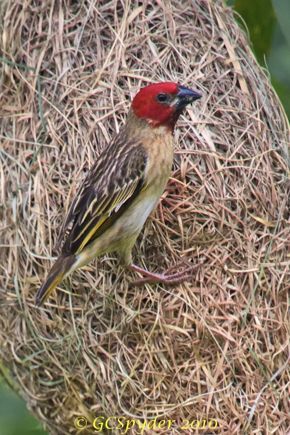GCSpyder photographed a breeding adult Red-headed Quelea (Quelea erythrops) in the latter part of March 2010 at Jalan Gemala 2, Singapore. This is an African weaver and its presence in Singapore is obviously as an escapee.
In April Howard Banwell photographed a red headed “Baya Weaver” ripping apart an uncompleted Baya Weaver’s (Ploceus philippinus) nest. Yong Ding Li suggested that it might be a Red-headed Quelea, one of those gregarious finches of the African grasslands. On the other hand it could well be a Cardinal Quelea (Quelea cardinalis) subspecies Rhodesia, which looks like the Red-headed Quelea (Zimmermann et al., 1999).
So, within a period of about two weeks, two sightings were made of the African weaver at opposite ends of the island. Is there a possibility that these queleas were released to coincide with a religious festival? Just a thought.
Image by GCSpyder.
Reference:
Zimmerman, D. A., D. A. Turner & D. J. Pearson, 1999. Birds of Kenya and Northern Tanzania. Russel Friedman Books CC. South Africa. 576 pp.
This post is a cooperative effort between NaturePixels.org and BESG to bring the study of bird behaviour through photography to a wider audience.










3 Responses
The birds commonly released by misguided worshippers are usually the munia species common in South East Asia. I do not intend to insult any religions, but the people who release birds are considered to be misguided even by the priests of their religion, who well understand that there is no merit to be gained in Heaven by encouraging trappers to subject birds to the stress of capture so that someone else can release them.
A local, Malaysian or Indonesian munia costs between $3 to $5.
A weaver imported from Africa costs anything from $40 to $100.
It is therefore unlikely that these African weavers were purchased for the purpose of release, since people who do so consider a bird to be a bird, regardless of unit cost.
It is more probable that the African weavers either escaped, or, when they went into their eclipse plumage and lost their brilliant breeding colours, their keeper got too impatient to wait another year for the birds to become beautiful again and simply dumped them.
Dear Alex,
The shama without tail feathers could possibly have been one trapped with adhesive. When shamas get stuck in glue traps, their feathers often come off.
Very intrrasting